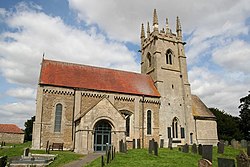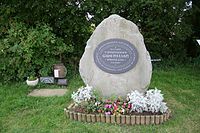Sempringham
| Sempringham | |
| Lincolnshire | |
|---|---|
 St Andrew's Church | |
| Location | |
| Grid reference: | TF117332 |
| Location: | 52°53’7"N, 0°20’28"W |
| Data | |
| Postcode: | NG34 |
| Local Government | |
| Council: | South Kesteven |
| Parliamentary constituency: |
Grantham and Stamford |
Sempringham is a hamlet in Kesteven in Lincolnshire, which is to be found two miles south of the A52 road and twelve miles east of Grantham. The hamlet shares a civil parish with nearby Pointon ('Pointon and Sempringham').
This is a parish on the edge of the Great Fen.
Sempringham was once the site of a mediaeval priory, of the Gilbertine Order; the order was founded by a monk from the village, Gilbert of Sempringham, the son of the lord of the manor.[1][2] The priory was the lifelong home in exile of the Lady Gwellian, only child of Llwelyn the Last, Prince of Wales.
Sempringham today consists of a church and a holy well, with other houses east from the church scattered along the B1177 between Pointon and Billingborough. Pointon is the chief township of the parish, which includes Millthorpe and the fens of Pointon, Neslam and Aslackby, and a part of Hundred Fen at Gosberton Clough.
Parish church
The parish church is St Andrew's. It is a Grade I listed building, dating from 1170. It was restored and the chancel rebuilt in 1868-69 by Edward Browning.[3]
History
Sempringham is noted in the Domesday Book as Stepingeham in the Aveland Hundred of Kesteven. In 1086 the manor consisted of 35 households, 8 villeins, 2 smallholders and 14 freemen, with 4.3 ploughlands, a meadow of 11 acres and woodland of 7 acres. In 1066 Earl Morcar was Lord of the Manor, which was transferred after the Conquest to Jocelyn, son of Lambert in 1086, with Alfred of Lincoln as tenant.[4][5]
In the early 17th century, Sempringham was a centre of the Puritan movement in Lincolnshire. Samuel Skelton, curate of Sempringham, sailed to Massachusetts Bay in 1628 with the first group of Puritan settlers, who landed in Salem, Massachusetts. Another member of the Sempringham congregation at the time was the young Anne Dudley, later Anne Bradstreet, the colony's first published poet.
Sempringham Priory
Sempringham is the site of St Mary's Priory, a priory of the Abbey of Peterborough that was founded by Saint Gilbert (also known as Gilbert of Sempringham). It stood the west of today's hamlet, at TF109326.
The priory was built by Gilbert of Sempringham.[1][2] St Gilbert established the Gilbertine Order in 1131 by inducting ‘seven maidens’ who were his pupils when young. Alexander, Bishop of Lincoln, helped in establishing the religious buildings to the north of the parish church. Gilbert died at Sempringham in 1189 and was buried in the priory church. He was canonized on 13 October 1202 for the many miracles noted at his tomb in the priory and Sempringham became a site of pilgrimage.
Sempringham Priory became the enforced residence of Gwenllian, the only child of Llywelyn ap Gruffudd (‘Llywelyn the Last’), Prince of Wales. Gwenllian was born in 1282, her mother, Eleanor de Montfort, dying in childbirth. Her father Prince Llywelyn was slain in combat just six months later, at the end of his war with her maternal uncle, King Edward I. Llywelyn's brother Dafydd led a brief rebellion but was captured in 1283, as was Gwenllian, a mere baby. King Edward sent Gwenllian 'in her cradle', to Sempringham be held there in security, never to bear an heir for her father’s ancient line. In 1327, Edward III stayed at the Priory and granted Gwenllian a lifelong yearly pension of £20, necessary to pay her board and lodgings as she never became a nun, but was regarded as a 'paying guest' who was not permitted to leave. Gwenllian died at the Priory after being held there for 54 years, on 7 June 1337.
At the Dissolution of the Monasteries, Sempringham Priory came to the Clintons, who demolished it and reused the stone to build their residence on the site. Today little remains of priory or residence.
In 2001 the Princess Gwenllian Society commissioned a memorial stone which was erected in her honour at the site of Sempringham Priory, replacing an earlier memorial installed in 1993. In 2008 another memorial was placed on the summit of Snowdon and the next year a mountain above her birthplace in Snowdonia was renamed Carnedd Gwenllian.
Outside links
| ("Wikimedia Commons" has material about Sempringham) |
- National Monuments Record: No. 350979 – Sempringham
- Sempringham, Homepages.which.net. Retrieved 22 May 2012
- Information on Sempringham from GENUKI
- The Gwenllian Memorial – The Princess Gwenllian Society
- "Sempringham", Parliamentary Gazetteer of England and Wales (1843-4)
References
- ↑ 1.0 1.1 Houses of the Gilbertine Order
- ↑ 2.0 2.1 "Handling Pilgrims: Robert Mannyng and the Gilbertine Cult". Quaestia: Journal Article. http://www.questia.com/googleScholar.qst;jsessionid=36B8F2B6D842F7DFA8CFEC357EC9357C.inst1_3a?docId=5008186623. Retrieved 21 December 2010.
- ↑ National Heritage List 1241280: St Andrews Church
- ↑ Sempringham in the Domesday Book
- ↑ "Documents Online: Sempringham, Lincolnshire", Folio: 356r, Great Domesday Book; The National Archives
